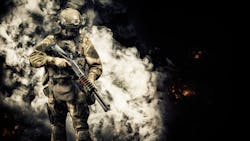Practical Weapon Accessories & Modifications
For 99% of everything you’d ever need to do with your weapon, the departmentally issued handgun, rifle or shotgun will suffice. If that’s so, then why is there such a huge aftermarket business for weapon accessories, upgrades, and more? If the weapons are good enough for law enforcement, why wouldn’t they be good enough for the competition or even just weekend shooter groups? When you think about it, the harm done can be far greater if a law enforcement professional misses his target. We spoke with two current firearms instructors and got their inputs on what’s best for today’s streets. Let’s discuss some of the accessories that can make your weapon better suited for duty use. Neither instructor wished to be named.
Handguns
Often times, the biggest challenge with an issued handgun is how it fits in the officer’s hand. Grip comfort is as individual as each officer but thankfully there is quite an assortment of ways a handgun’s grip can be modified for comfort. With weapons that support the option, make sure the circumference of the grip is proper for the shooter’s hand. It’s easy to identify if the grip is too big or too small. Interchangeable backstraps can easily adjust the grip size. Sometimes though, the challenge isn’t size but texture. Companies like Talon Gun Grips make appliques (adhesive wraps) that change the grip texture, offering a more secure feeling for the shooter. If such options don’t work, there is an assortment of custom shops that will change the shape, texture, etc. of the grips—at least on polymer-framed pistols.
Beyond the grip, sights are probably the most important part of a weapon. Many agencies issue duty weapons with standard sights which can be hard to see, pick up, and/or align in low light conditions. Good quality night sights, such as those from Meprolight or Trijicon, can be installed to increase visibility and help overcome the challenges of low light sight picture.
Another option for dealing with low light situations is to mount a flashlight/laser unit on the handgun. Many agencies permit these and provide or authorize the correct holsters for such. In our discussions about weapon lights, one of our instructors was quick to point out that there is no magic accuracy imparted by the light/laser unit. The other was just as quick to add that too many agencies authorize weapon lights but don’t have the requisite training built into their firearms programs. Manipulating a light and/or laser in addition to properly handling the weapon and keeping all basic marksmanship skills intact can present a challenge without adequate training.
There are plenty of other modifications that can be made to the typical handgun, but the grips and sights are by far the most important items that can impact an officer’s comfort and competence with the handgun in question.
Rifles
Typically, the more gun you have, the more modifications and accessories you can have. With today’s common patrol rifle (an AR-15 type platform more often than not), the agency may or may not issue an optic, sling, spare magazines, etc. As much as experts argue what’s necessary on any weapon, there are a few things our two subject matter experts agreed on.
The first they mutually agreed on was spare magazines, but they disagreed on how many. One felt that three spare magazines should be the minimum while the other felt one was plenty. Being realistic, if we need more than 60 rounds of ammunition in any given conflict, it’s uglier than we anticipated. Hopefully, there is a lot of backup on the way. The challenge then becomes how to carry those spare magazines. Both instructors and I all agreed that ideally, the officer carrying a rifle would be wearing an external vest with plates and equipped with magazine pouches for the spare magazines.
A sling was the next accessory that all instructors mandated. Once out of your vehicle holding your rifle, you can’t just set it down when you need both hands for something else. A sling is mandatory so you can sling the rifle and keep on functioning.
There was some debate about weapon-mounted lights, laser aiming devices, pop-up sights versus fixed sights, and more. We all agreed that much of these came down to perceived need, shooter skill, training level, and agency approval. Optics are a great idea if you can adequately train with them and also train for using hard sights when the optics fail or are broken.
Shotguns
There are a plethora of accessories you can get for or on your weapon. Remember, extra training is required for just about every one of them and you do yourself a disservice if you don’t put in the practice time.

Lt. Frank Borelli (ret), Editorial Director | Editorial Director
Lt. Frank Borelli is the Editorial Director for the Officer Media Group. Frank brings 20+ years of writing and editing experience in addition to 40 years of law enforcement operations, administration and training experience to the team.
Frank has had numerous books published which are available on Amazon.com, BarnesAndNoble.com, and other major retail outlets.
If you have any comments or questions, you can contact him via email at [email protected].






